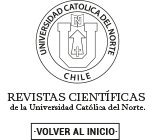Internal Structure and Metric Invariance of the Academic Self-efficacy Scale Ases
DOI:
https://doi.org/10.22199/issn.0718-7475-2019-02-011Keywords:
Auto-efficacy, Validity, Factorial analysis, Equivalence/invariance of measurementAbstract
AIM: The study presents the results of the adaptation of an academic self-efficacy scale. Specifically, the purpose of the study was to analyse the internal structure of the translation and adaptation of the ASES scale by Chemers, Hu y García (2001). METHOD: 4950 Chilean university students participated. Additionally, to study the Equivalence/Invariance of Measurement between different groups of students, we have performed a factorial invariance analysis. RESULTS: The results indicate that the scale has adequate psychometric properties; they also show the existence of a two-factor structure consistent from the substantive point of view and with an adequate statistical adjustment. Factorial invariance analysis shows the existence of metric invariance between the compared groups, CONCLUSIONS: The evidence shows the validity of the scores and their equivalence among groups of students.
References
Bandura A. (1997). Self-Efficacy: The Exercise of Control. New York: Worth Publishers Ltda.
Bentler, P. M. (1990). Comparative fit indices in structural equation models. Psychological Bulletin, 107(2), 238 – 246. doi.org/10.1037/0033-2909.107.2.238
Bell, B. S. & Kozlowski, W. J. (2002). Goal orientation and ability: Interactive effects on self-efficacy, performance, and knowledge. Journal of Applied Psychology, 87(3), 497-505. doi.org/10.1037/0021-9010.87.3.497
Brown, T. (2006). Confirmatory factor analysis for applied research. New York: Guilford press.
Chemers, M. M., Hu, L. & García, B. F. (2001). Academic self-efficacy and first-year college student performance and adjustment. Journal of Educational Psychology, 93(1), 55 – 64. doi:10.1037//0022-0663.93.1.55 2001.
Chen, F. F. (2007). Sensitivity of goodness of fit indexes to lack of invariance. Structural Equation Modeling, 14(3), 464 – 504. doi:%2010.1080/10705510701301834
Cid, P. Orellana, A. & Barriga O. Validación de la escala de autoeficacia general en Chile. Rev. Méd. Chile. 138(5), 55 – 557. doi: 10.4067/S0034-98872010000500004
Cortina, J. M. (1993). What is the Coefficient Alfa? An Examination of Theory and Applications. Journal of Applied Psychology, 78 (1), 98-104. doi.org/10.1037/0021-9010.78.1.98
Dimitrov, D. (2010). Testing for factorial invariance in the context of construct validity. Measurement and Evaluation in Counseling and Development 43(2), 121-149. doi:10.1177/0748175610373459
Feldman, D. & Kubota, M. (2015). Hope, self-efficacy, optimism, and academic achievement: Distinguishing constructs and levels of specificity in predicting college grade-point average. Learning and Individual Differences, 37(1), 210 – 216. doi:10.1016/j.lindif.2014.11.022
Horn, J.L. (1965). On the use of random variables in factor analysis. British Journal of Mathematical and Statistical Psychology, 19(1): 127 – 129. doi: 10.1111/j.2044-8317.1966.tb00361.x
Hu, L-T. & Bentler, P. (1999). Cutoff criteria for fit indexes in covariance structure analysis: conventional criteria versus new alternatives. Structural Equation modeling. 6(1), 1 – 55. doi.org/10.1080/10705519909540118
Izquierdo, I. Olea, J. & Abad, F.J. (2014). Exploratory factor analysis in validation studies: Uses and recommendations. Psicothema, 26(3), 395-400. doi: 10.7334/psicothema2013.349
Lorenzo-Seva, U., & Ferrando, P.J. (2006). FACTOR: A computer program to fit the exploratory factor analysis model. Behavioral Research Methods, Instruments and Computers, 38(1), 88-91. doi.org/10.3758/bf03192753
Luijben, T (1989). Statistical guidance for model modification in covariance structure analysis. Amsterdam: Sociometric Research Foundation.
Maddux, J. Shererm, M. & Rogers, R. (1982). Self-efficacy expectancy and outcome expectancy. Cognitive Therapy and Research, 6(2), 207-211. doi.org/10.2466/pr0.1982.51.2.663
Messick S. (1989). Validity. In: Linn RL, Editor, Educational Measurement. New York: American Council of Education/Macmillan. pp. 13-103.
Messick S. (1995). Validity of psychological assessment: Validation of inferences from persons’ responses and performances as scientific inquiry into score meaning. American Psychologist 50 (9): 741-9. doi.10.1037/0003-066X.50.9.741
Multon K.D., Brown, S.D. & Lent, R.W. (1991). Relation of self-efficacy beliefs to academic outcomes: A meta-analytic investigation. Journal of Counseling Psychology, 38(1): 30-38. doi:10.1037/0022-0167.38.1.30
Phillips, J. M. & Gully, S. M. (1997). Role of goal orientation, ability, need for achievement, and locus of control in the self-efficacy and goal-setting process. Journal of Applied Psychology, 82(5), 792-802. doi.org/10.1037/0021-9010.82.5.792
Pintrich P.R. (1999). The role of motivation in promoting and sustaining self-regulated learning. International Journal of Educational Research. 31 (6): 459–70. doi:10.1016/S0883-0355(99)00015-4
Pool-Cibrián W. J. & Martínez-Guerrero, J. L. (2013). Autoeficacia y uso de estrategias para el aprendizaje autorregulado en estudiantes universitarios. Revista Electrónica de Investigación Educativa, 15(3). Recuperado en 18 de febrero de 2017, de http://www.scielo.org.mx/scielo.php?script=sci_arttext&pid=S1607-40412013000300002&lng=es&tlng=es
Schunk D.H. (1991). Self-efficacy and academic motivation. Educational Psychologist; 26 (3-4): 207–31. doi:10.1080/00461520.1991.9653133
Schunk, D. & Pajares, F. (2005). Competence beliefs in academic functioning. In: Elliot AJ, Dweck C, Editors, Handbook of competence and motivation. New York: Guilford Press. p. 85–104.
Spormann C, Pérez C, Fasce E, Ortega B, Bastías N. Bustamante, C. & Ibañez, P. (2015) Predictores afectivos y académicos del aprendizaje autodirigido en estudiantes de medicina. Revista Médica de Chile, 143(3): 374-82. doi: 10.4067/S0034-98872015000300013
Steiger, J. H. y Lind, J. C. (1980). Statistically based tests for the number of common factors. Trabajo presentado en el Annual meeting of the Psychometric Society, Iowa City, IA. http://www.statpower.net
Wolters, C. A. Yu, S. L. & Pintrich, P. R. (1996). The relation between goal orientation and students' motivational beliefs and self-regulated learning. Learning and Individual Differences, 8(3), 211-238. doi.org/10.1016/S1041-6080(96)90015-1
Zimmerman, B. & Schunk, D. (2008). Motivation: An Essential dimension of self-regulated learning. In: Schunk DH, Zimmerman BJ, Ed. Motivation and self-regulated learning: Theory, research and application, New Jersey: Laurence Erlbaum. p. 1-30.
Published
How to Cite
Issue
Section
Los autores continúan como propietarios de sus trabajos, y pueden volver a publicar sus artículos en otro medio sin tener que solicitar autorización, siempre y cuando indiquen que el trabajo fue publicado originariamente en Revista Salud & Sociedad (ISSNe:0718-7475).


_(1).png)





